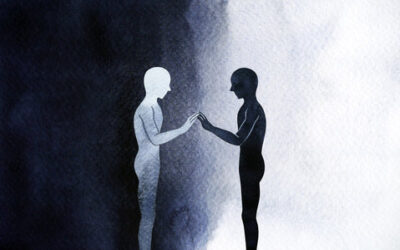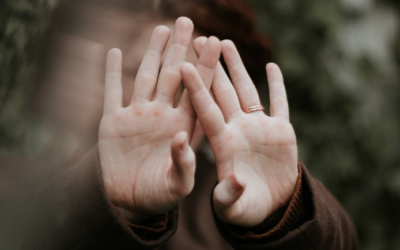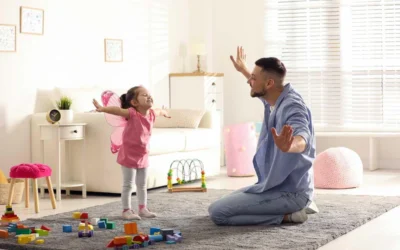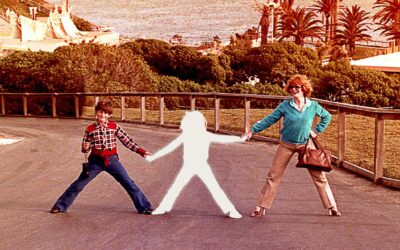Podcast: Play in new window | Download (Duration: 58:05 — 39.9MB)
Subscribe: Apple Podcasts | Spotify | Amazon Music
Social emotional learning for all of us – brain breaks not timeouts recommended
Brain breaks and the 3 C's for connecting.
Whether you're a parent balancing life in the pandemic or a teacher managing highly emotional kids, this episode is a resource for you.
Co-host Dr. Ann Kelley and child specialist, Lindsey Kealey dive into strategies for teaching kids how to regulate their emotions and promote positive connection with others, called social emotional learning. Linsey Kealey has developed a trauma-based, neuroscience-informed program that uses social emotional learning and problem-solving strategies to help all of us make positive decisions and thrive in our relationships. She utilizes the Three C's method, connect, calm and collaborate, to help transform the way we interact with ourselves and others. They discuss the three C method of connection to help cultivate healthy relationships and positive development in our children. .
Our guest today
Lindsey Kealey is a University instructor of human development and family sciences and education at Oregon State University. She is the author of PAWsitive Choices Social and Emotional Learning and the host of The PAWsitive Choices Podcast. Lindsey earned a Bachelor’s of Science in Human Development and Family Sciences with an emphasis in child development and holds a Masters of Arts in Teaching. Her university work, as well as her experience coaching families and teachers, helped her craft a curriculum that integrates interpersonal neurobiology, trauma-responsive practices, and problem-solving to help children thrive.

Lindsey Kealey working with social emotional learning
More about PAWsitive Choices…
PAWsitive Choices is a comprehensive social and emotional learning program for families and schools that teaches children how to regulate emotions, make positive choices, learn from mistakes, and collaboratively solve problems. This trauma-responsive curriculum equips educators and caregivers with practical tools and strategies to help strengthen relationships and promote resilience.
Show Transcript
Lindsey: So we almost think that this is going to take a lot of time, but in the long run, you'll find yourself having to teach less and less because they're learning those skills. They're internalizing them. So it can feel counterintuitive of well man setting up a brain break kid or teaching my child about problem solving.
It is a task. It is something to do, but not only is it going to make them more successful and thrive, it's going to help make our lives easier. And I think that's motivating for adults.
Today's session on social emotional learning begins right now with Dr. Ann Kelley and Sue Marriott.
Ann: Hi, welcome to the show. I'm here with Lindsey Kealey.
Lindsey: Thanks for having me.
Ann: I'm so glad to have you. So you are a social, emotional learning specialist for children. Is that right?
Lindsey: That's correct.
Ann: Well, Lindsey, tell us a little bit about yourself.
Lindsey: I am an Instructor of education and also human development and family science. With an emphasis in early childhood education. And I am a fellow neuro nerd. I love your podcast. It resonates with me so much. So I'm just really passionate about translating the science just as your podcast does to help, not only my university students and graduate students, but also families and elementary educator.
So I like to synthesize the science that's out there about our personal neurobiology and then infuse that both in my college courses and then also with family coaching. And when I go and coach in elementary schools, so it's really just an honor and privilege to get to work with so many different people in different sectors and disseminate this great information about how we can better connect with you.
Ann: And we need to continue to disseminate that for the young humans out there, because, you know, as a parent myself, all the information I could have used when my kids were younger, to help them deal with those huge, big emotions that they can have and you know, how to cope and really learn how to get ahold of themselves and to connect to other people. So when I took a look at your curriculum, I was really excited to have you on the show.
Lindsey: Thank you. It's really a neat position that we're in, whether we're educators or parents, or even just as we're connecting with our partners. If someone doesn't have children in their life, it's a beautiful opportunity for us to get to better understand ourselves and kind of our emotional landscape.
And then how that translates to. Who we're connecting with and how we can practice that empathy and then help others understand what's happening within them. If they're experiencing strong feelings. And that's something that I always talk about with my students and other adults I work with is that to begin, you want to explore your own emotional landscape and practice that emotional regulation.
And that's really what. Children can learn the best buys by modeling. So when we, you know, start with ourselves, then that's one of the best places to start. I think, I think some teachers and parents say, well, like I need to teach my kid. I need to change their behavior right away. And I think when we step back, it starts with us.
And that's really nice because we have a lot of autonomy and agency over our actions.
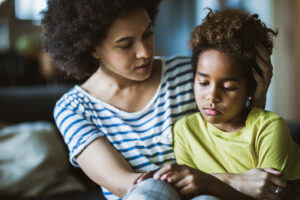
Young black mother taking care of her depressed little daughter at home.
Ann: Well, what do you typically try to teach your graduate students and parents and teachers about how to do that? Right? Because it's, it is such an important step instead of always being the teacher out there to our children, to really be able to understand how hard it is to do inside of ourselves and to be able to really model it.
So what if some of the things that you recommend when you're talking to parents and teachers?
Lindsey: Well to begin with, I like to bring attention to the work of Dr. Kristin Neff and self-compassion because trying to navigate social problems takes a lot of self-compassion and vulnerability, I think. And so being able to just like, put your hand on your chest and take that deep breath in and just give yourself.
Because as we're trying to connect with others and teach kids, you know, regulation skills with those big feelings, they experience, it's very likely that it could make us feel dysregulated. You know, I have this glitter brain frame. So if you think about for those listeners who can't see this, the picture frame that has the glitter in it, and I've just put a picture of a brain inside of that.
And if you think about the glitter as being kind of like the neuro-transmitters and chemicals in your brain, when you get really upset, I show this to my students and young children. It's almost like the glitter in your brain or those neurochemicals get all mixed up. So it's really hard to make positive choices.
It's hard to be our best selves and show up when we feel dysregulated. And I think one of the most encouraging things that I can tell people is that one of the best ways to model vulnerability and to help build resilience in children is to repair with them. So I have. A big glitter brain and the small one.
And so when our brains get dysregulated and maybe you know, we're not super kind, or we said, we say, Hey, I told you that five times sit down and maybe we're not showing up how we'd like to, we can simply model for children or even, you know, our other adult relationships and say, you know what? My brain felt really mixed up.
I was really upset. And I'm sorry for speaking to you the way I did. And next time I'm going to take calming breaths and I'm going to try some things out to help my own brain. And I'm sorry about. The way I talk to you. So when we repair, I think that kids learn so much, you know, we don't have to worry about being the perfect parents to the perfect teachers or the perfect partner, but rather we can model repair and we can come together and really solve those social problems.
Ann: You don't have to hold the idea of perfection that we're not going to make mistakes. And so often we want to rush in and explain why we did something don't we like, no, let me tell you I'm so charged up, but this is why you need to understand. The concept of letting your brain kind of settle so that you can find your body and then come to the connection. Yeah, that's a really important reminder, I think to us all
Lindsey: yes. And I think when we start just by saying, you know, I felt really upset. I felt really dysregulated. If you're speaking to an adult, like you mentioned, rather than going into a list of reasons of why we did a certain thing, or, well, I talk like this because you did X, Y, and Z.
If we just say, you know, I had a lot of strong feelings when we had this discussion that almost lets the other person kind of take a sigh of relief and it feels like you're on the same team rather than the other person getting on the defense and saying, well, I had these reasons why I acted like this in the first place. So if we just say, you know, I had these really strong feelings that I'm kind of wrestling with or working through that. It's like it unites our common humanity with one another.
Ann: Well, when you're trained to help parents or teachers, let's think about the kids with big emotions, with their bodies, for whatever reason, history experience, but they tend to have huge emotions, and dysregulate frequently. Those can be really tough times to be able to get ahold of yourself and parent. But what are the things you recommend? Like what do you talk to individuals about how to deal with a child that is extremely dysregulated and upset?
Lindsey: I actually have a lot of experience. One of the beginning of my educational journey and my journey to creating a social emotional curriculum started my second year of teaching.
I began as a kindergarten teacher and day one, I thought this is going to be a great year. And it turned out that I had seven students who had really strong social, emotional, and behavioral challenges or needs. And so that looked like certain students hitting one another, you know, running out of the classroom, a lot of physical aggression and violence I saw and a big part of that had to do with trauma and adverse.
Experiences. And when I learned about their backgrounds and where they're coming from, the amount of stress that was flooding their systems, it was just astonishing that they could come to school to begin with and show up. So that certainly gave me a lot of empathy, as I learned about trauma and how that affects the brain.
So that kind of set me off on a pathway of how do I help children who were literally throwing chairs across the classroom or who are running out the front door of the school. And now we're calling backups to find kids in the neighborhood. I mean, this is something that some teachers will experience really big problems and behavioral challenges.
And so I kind of started with a host of behavioral challenges that were extreme. And then I kind of worked backward from there.
Ann: I can imagine teachers out there can really relate to what you are saying. And I I'm thinking about being in your position and having students run all over the place and you can have deep compassion for their histories, but you also have to like manage them.
And I just have such empathy for teachers out there. And I think actually after the year of the pandemic, I think a lot more of us have a kind of connection to teachers and what they have to deal with on an everyday basis because what's coming together for them is a history. Probably many kids that have had trauma and have that manifested in terms of dysregulating and behaviors that are tough. So anyway, I just think about that from a really compassionate place for the teachers out there and for you in that moment and trying to go, ah, how do I deal with it?
Lindsey: Definitely. So beginning with just connecting with yourself and again, holding space for self-compassion and telling yourself, wow, this is really hard. I mean, there was this bout of physical aggression with these students and I need to really be at a place of peace as much as you can. Right. That's challenging to do that, but before you engage with children or with a difficult situation, being able to make sure your brain is calm and ready to teach. I think that's really huge.
So in working with children with a variety of needs, and then also with working with children who maybe don't have trauma or a lot of challenges, I found there are three practices, three things you can do that I call the three CS and that is to connect. To calm and then collaborate. And I found that when you do those three things, really with any problem that you have, it helps you get to the end, the ultimate goal, which is to have accountability, to have repair and to really teach kids to build skills so that they learn from that experience.
So when you connect with the child, that could just be acknowledging where they're coming from, you could just narrate their experience. I could tell you a really upset when you know that student took the ball out of your hands. That really made you mad. Gosh, it's frustrating when people take things out of our hands. So that's just the first day just connecting with them.
Ann: That's not an easy step though, right? Like it can sound easy. Right. You know, connect first, but you're describing kids that are hitting one another. Like how do you take a moment for the of connection when you're in the middle of this really intense behavioral acting out.
And I know parents, and even when I've talked with couples, when they're really, really angry, that connection step can be so difficult. How do you help people make that first step? I want to go to the calm and the collaborate whole heartedly agree with you, but let's take a moment at that first. What do you recommend? How do you help people connect?
Lindsey: Well, if someone, maybe let's say one person who's trying to facilitate the problem solving is also dysregulated, you could start by just saying, I can tell you're upset and you know, if you're not in a head space to start to guess, well, are you frustrated? Are you sad? You could just start by saying, I can tell that your brain feels mixed up or that you feel upset. And I think that allows the other person to feel, felt like Dr. Dan Siegel. So the person just knows, oh, you can tell something is on my heart or I'm, I'm having a difficulty with the situation. So to say, I can tell you're upset.
And then I think that allows the other person to feel felt. I think that's a pretty simple thing to say and then move on from there when you can. So maybe it's, you're not in a situation where like, for instance, if it's a safety issue in the classroom to say, oh, I can tell that maybe if it's two children, both of you are really upset.
We need to change how our environment looks right now. So let's have this student go over. I call something a brain break. So that's allowing students and I'm showing to the screen now a little tub with calming tools inside of it. So rather than hopping to, I need to teach you a lesson or tell you why your behaviors were right or wrong.
That's the third C collaborate. We need to first get them in a place where they're able to calm down. To be able to learn and be ready to hear what you have to say. And so you could say, we need to, you know, the second C is to calm. Let's take some deep breaths, let's get you in a space that's safer, or that allows you to feel settled before we start problem solving this situation.
And for adults that could be like, I can tell you're upset. What do you need right now? So maybe the other person accused them into oh, My brain probably needs something. You know what? I'm going to go take a lap around the neighborhood cause I might need to get my energy out. So that's something where we can help the other person identify that they need to meet one of their own needs
Ann: One of things as that it can be just a quick line, right? It's not that you have to kind of sit down and have this empathetic moment with a kid that is acting out. But what you're saying is even if you just observe about what's going on in the connection, I see you're upset. You're probably both upset. That ,in and of itself, that quick line is a step into the experience of connection.
That kind of calms the nervous system in that one moment. And so often we jump up with trying to teach the lesson, and that is as a parent, as a partner, it's like, let me tell you why I'm upset. So I know I keep saying that, but it's so hard for our nervous systems to calm down. So I like what you're saying. Sometimes it's just one quick line. It doesn't have to be a momentous moment.
Lindsey: Exactly. And I found that when you skip that connection piece and you go straight to calm some of us, maybe we don't go straight to the collaborate. And I want to tell you why you're wrong or let's fix this. Sometimes we start with, we want to help them calm down.
We see that need, but we say you need to calm down. And oftentimes the other person isn't necessarily receptive to that. What do you mean? I need to calm down, calm down, right?
Ann: Somehow that never works. You know, if you say calm down, don't be afraid. Okay. Let me get busy, let me get right on that (both laughing)
Lindsey: It's powerful just to say I see you. I can see something's up and you could say, I see that both of us are upset. We both need to take a break. I think that we need to regroup or for children I say, we need to let our brains settle and then we can come back together. But you know, right now I need to go sit at my desk and take a sip of my coffee and what do you need?
Okay. You can go take a brain break or maybe you can just do a lap around the recess. So, you know, the playground let's help you calm down. So I think when you really get to the bottom of it, it's helping children become regulated, building those skills for them, and then being able to teach. Help them understand why, whatever they did was a problem, so they can move forward and then have that long lasting behavioral change is the ultimate goal.
I think with maybe even beneath that is strengthening our relationships because really kids don't care what, you know, until they know that you care for them. So that's a big part of it strengthening that relationship.
Ann: Yeah. I like the way you're saying .Kids don't care what,you know until they feel like you care. That's a really powerful statement.
Lindsey: I'd have to look and see who it's attributed to. It might be too anonymous, but that's something that I, I always go back to with my graduate students who are thinking, well, I need to get the reading, writing, math scores up, you know, when they're doing their student teaching placements, they're so focused on maybe a child's behavior. I need them to sit at the carpet and listen, otherwise their reading score isn't going to be where I need it to be. But if we say relationships first, academic second. Then actually that's the most productive approach to take, because if the child's not in the learning state, if their brain's not regulated, if their prefrontal cortex is not online, then they're not going to get that reading skill.
They're not going to learn multiplication or division when they're in that brain state. So it's one of my joys in what I do is helping people make that realization and have that aha moment.
Ann: In those steps we've talked about the three C's and we've talked about the connect and then the calm. And you mentioned the brain break. Talk a little bit more about the brain break. I think that's part of what your curriculum is based on, is that right, about ways to help individuals first connect, but then in the calming place that there's things that they can do to calm themselves before they jump into the collaborative. Can you talk a little bit more about the brain break?
Lindsey: Definitely. So I think that oftentimes as adults, we want to help children calm down and we all know that something that needs to happen, especially when you're in an aisle at target and maybe you're with your child and they're having a moment because they want a toy. And you said, no. So we all want them to experience that sense of calm.
But in my research, I've looked at the things that get in the way. And so some common practices like. Or in the educational setting and classrooms that might be, oh, you're missing five minutes of recess or you're missing fun Friday, or there's different things that we do with the best of intentions, thinking that telling a child, oh, you need to go take a timeout.
We think that's going to help them calm down. However, if we look back at that, what does that ultimately accomplishing. Some of the unintended consequences of having children take a timeout is if they're going over to a corner of the room, let's say in the house, and they're just sitting there rather than thinking, you know, wow, what I did was wrong. And I put that made my sister feel really upset when I did this or that. So what we really want kids to do is still feel like they're connected to us and that they're worthy of love and belonging. So if we say go take a. You just did something really bad that can kind of cause a rupture, a disconnection.
So if we say something like, you know what, buddy, I can tell your brain feels mixed up. Let's have you take a brain break or a calming break. That way you're feeling better. And then we can solve this problem. So it's really, it's not putting the blame on the person. So that's shame. I am that. And then.
Guilds Bernay Brown's work. What I did was bad. And so when we are able to shift our language, take a linguistic turn, so to speak and say, you know what, let's help your brain settle down rather than take a time out. Ultimately it's accomplishing the goal of having a child remove themselves from maybe a situation, maybe it's Thanksgiving dinner, and they're, you know, having a moment, they have those strong feelings.
It's allowing them to remove themselves from that environment or that situation. But we're wording it in a way that promotes shame resilience and that fosters a secure attachment. So I think that's powerful. So a brain break really is allowing a child to go to a space that's safer and that's calm for them.
And then know that they have a variety of things they can do to help their brain feel settled. So that's the goal. And when we think about how we tell them to do that, it can make a big difference.
Ann: You think about shame is being sent out of the village, right? That's kind of what induces shame historically.
And. To like go take a time out is this inducement of you've done something bad and now we need to punish you. Right. And, and like you said, all of a sudden I have this idea of this child in the corner and no you're right. Unlikely that me, myself in the corner as a child or anyone else will be sitting there really having reflective functioning about how much they made a mistake and how much they desire to repair. Not so much. Right.
Lindsey: Exactly. And it can go one of two ways or it can go both ways. There's a variety of ways this can go, but it's oftentimes either my mom or dad they're so mean I don't deserve this or that could also be I'm so bad and I'm not even good enough to sit at the table with, you know, at Thanksgiving or, you know, my family doesn't care from your love and be like, I can't even be around them.
I'm unworthy. And so I would rather have a child have their response and their brain of thinking, wow, if maybe at their grandparents' house, grandma's really mean. I'd rather have almost have that cognitive pattern because the child's not internalizing shame thinking that they are bad, but ultimately we don't want our children to be having this reflective time where they're thinking we're all bad.
Right. Right. And we want them to feel like we're on the same page. So something that happens I think is when I propose that we can shift our understanding of time outs, I get the response from parents of, well, what do you mean time outs are bad? You know, maybe they grew up in, they were spanked or they had other forms of discipline that didn't feel good.
And so they're thinking I don't want to go that direction. So I'm going to go with the timeout in their mind. They're thinking that's so much better than these other really punitive responses that caregivers can provide. And so I think. If we're able to let parents know, and I make this clear with my graduate students as well, is that, we're not saying that we're just letting accountability fall to the wayside.
You know, we're not saying, oh, your brain's upset. And you know, kumbaya gave me a hug. Now we're walking. We were going right along. We wanted to backtrack because it's really important for us to have those boundaries. Right. It's in our children's best interest to help them learn from their mistakes rather than when parents say, oh, doesn't a brain.
Isn't that like a permissive thing to do, but it's like, oh, actually rather you're allowing that child to calm down to still feel connected to you. And that's why you have to follow up with problem solving. That's a really important piece that has to be there.
Ann: Well, I also think the piece of the brain break, as you're talking about it, it feels like it really also supports accountability, right? Because it's, it's not even the, what falls after that, where the time out is not really fostering accountability where you're saying, take a brain break. You're suggesting your brain is dysregulated. And so you've got to go and actively work on calming yourself down. And I love that you have like a, a brain break bucket and it's good for all of us.
I need a brain break sometimes, you know, like, like what are the things that would go in your personal bucket as an adult, but also as a child? Like, what do you put in your bucket that actually lowers your cortisol level and calms you down, but keeps you connected. But there's also this active engagement with yourself instead of, like you said, letting yourself run into the rumination of “I'm a victim or I'm a perpetrator”, right? Like I'm so bad or the world's so bad. It's like, I'm so dysregulated and I'm upset because I've been connected with, by, I hear you're upset, so I'm going to, I'm going to calm myself down and it really does support that journey. Doesn't it, to the next.
Lindsey: Exactly because one of our goals is to build skills.
So when, when our children progress or development, and now they're in high school, we want them to have healthy coping mechanisms. And one of the reasons that sometimes when a parent will say, well, you know, why do I need to take the time to build a brain break kit or to teach healthy choices to my child?
Let's say five years old. Well, one of the reasons is let's look down the developmental trajectory when they're in high school, we want them to have skills. So when they're under extreme pressure, we don't want them to go out and, you know, use drugs or to do behaviors that are risky to their health or to others.
So it's important for us to take a skill based approach and to help kids understand that they have autonomy and agency over what they do when they're feeling dysregulated. That's really important.
Ann: Absolutely. They're also teaching that, that pause, and that reflective functioning is so important, right? Because I think of how often people, one of their brain break is they're going to go pick up their phone, but it actually for older individuals that is not actually adding to reflective functioning, is it, it's just like that. Like, what's the difference between a brain break and just sort of distancing.
I'm going to take a break, but I'm actually going to go away and. You know, completely disconnect from the moment in my body where a brain break is teaching from the very youngest age, it seems a way to take a moment to go and calm down and self-reflect et cetera, instead of just disappear. So it seems like it really is teaching developmentally this step of stopping and going internal and being aware of the internal.
Lindsey: Exactly. And I think having intentionality around it and having a game plan of connection. So it's not go to your room and take a brain break so we can start to shift our language. And how about you go take a brain break, help your brain feel better, but if we don't have that wraparound where they come back and connect with us again.
It can kind of undermine our original purpose. So if you say, okay, go take a brain break. When you're ready, let's come back and talk about this. So there's that intentionality rather than a child grabbing their little tub and just taking the Legos out. Okay. Now it's time for dinner. It's almost like you're completing the stress cycle.
They they're able to calm down. Now we come back together and we say, okay, let's talk about that. How are you feeling now? What was going on for you? I think it's important. Same thing with our adult relationships. If you have an argument I know from personal experience with my husband, if you know, if we have some challenges in our relationship and we say, okay, we need to take a break.
I'm going to go on a walk. Okay. You're going to maybe even play video games, maybe an adult that is helpful for them to calm down. Let's come back together. What do you think? Three of. Okay, great. Three o'clock let's come back and we'll talk about this. So you have that intentionality of, we are going to connect with each other.
Again, some people they scroll Instagram and maybe that's exactly what they need in the moment. And when they know that they are going to come back and repair or connect, then I think that can really be helpful.
Ann: And that's the last, C, the collaborative, like, so you're going to take this part to calm and to really collect yourself. And then. The idea of collaborating, we are going to come back together and then that that's so helps. We always talk about this on the podcast of how much that promise that we are going to come back in and that plan holds that connectivity and, and you can't completely disappear into your own stuff because you know, you're going to be coming back and talking. So you have to reconnect to it. Kind of have some mindsight about it
Lindsey: Precisely. It's some of the things that would maybe go on a child's brain break kit or tub.
Ann: Perfect. Next question. I was going to ask you, what would you put?
Lindsey: So it's really powerful when you have a child come alongside and kind of co-create it with you.
So a lot of times when I work with parents, they could have like, you know, a journal and Crayons. I think it's powerful to have a mirror for younger kids, especially, and pair that with an emotions chart so when they sit down, they can start to think, well, how do I feel? And with the curriculum, there's like brain breaks steps.
So they really have a clear picture of, okay, I start with the timer. So I highly recommend that caregivers or even in the classroom, a lot of teachers are doing this in their classroom, having some kind of visual time. So a child knows, okay, I'm going to do this for five minutes. There's kind of like a limit.
They know whether it's a timer like this or a sand timer. They're watching the sand go down and they're getting a feel for, okay, I'm halfway done with this little break of mine.
Ann: So you may have a timer put in the bucket so that they're aware of timing. Is that what you're saying? That they're aware like, oh, I'm going to do this and for this amount of time and they can feel it. And then you mentioned a feeling's chart and mirror, tell me a little bit more about the mirror. Why a mirror?. And would that be for all ages? What are your thoughts about that?
Lindsey: You know, it really can start as young as children who are ready for it. So if you kind of go through, if you have a clear picture for what kids can be doing, when they're in a brain break, Write it down or you have pictures of them doing it, or, you know, if you have something kind of like a visual aid, you want them to be able to know they're setting the timer, have them begin with breathing because it's really difficult to connect with what your feelings are if you're not in a calm state of mind, because it does require your prefrontal cortex and critical thinking to don't. Well, what am feeling? And maybe for children as young as two or three, maybe they're not in the place with their emotional literacy to do that. And that's powerful as adults when we come alongside and sit down with them and maybe you hold the mirror up and say, I wonder how do you feel?
And so if you have an emotions poster where you're able to juxtapose what their face looks like in the mirror, and then hold that. The feelings poster and say, oh, your face kind of looks like this one, how your eyebrows are tilted down and you have a little cheer here and you're just kind of bringing awareness to their somatic experience and helping them understand how they feel.
So that's a step certainly that a child could take. And then also you're going to want to have them have a healthy choice of some kind. So. Kranz and a journal or Play-Doh or a favorite book, a stuffed animal, maybe like a little, you know, a set of Legos. Some kids really benefit from just starting to tinker with something that helps them calm down.
Some parents will say, well, aren't we just rewarding them. They get to go over and then play with Legos. Like right. Sometimes parents can think, wait a second. That might not feel right. But if, as long as we understand the goal is for them to settle and develop healthy coping skills. And I always say, remember when your child.
Well, we want them to do something healthy when they're upset. We want them to read a book. Goodness. If they could just play some video games or do some kind of building of some kind, rather than going out and doing risky behavior, that's really powerful. That's what we want. And so understanding to give kids tools like that is really powerful for them to know what to do to help their brains feel better.
Sue: Hey, we'd like to extend an invitation to join our private community at Therapist Uncensored.com/join – that is supercast.com. This Group is growing, it's thriving. There are reading pods, and you will receive an ad-free feed and you're going to get first crack at super exciting things that we do periodically bringing some of the authors in studying directly with for as little as $5 a month, please sign up at TherapistUncensored.com/join
Ann: And so part of your curriculum is having pictorial representations of these kinds of steps. So that younger kids who can't track all that, and don't have the kind of sequencing that would needed to go from one step to the other.
Lindsey: Some of the curriculum walks you through the steps in a pictorial way. For those that are just listening and not being able to see these pictures, have these steps along the way that can help them identify their feelings, et cetera, and help them know, oh, I breathe here. And then I go from one place to the next.
I have a free YouTube video that explains how to set up a brain break, what can go inside and it's done in a kid friendly way. So you could sit with your child, you could watch it together. So they have the background and then create your own calming kit of sorts.
So that's something that I will share with you so that listeners can have that as a resource, just to kind of get a feel for maybe if this is something they want to do.It's a starting point for.
Ann: That's terrific. And we'll have that in our show notes. We'll have a link to that in our show notes. So anybody listening and can get some brainstorming ideas, how to make your own brain break. And also just, I would love adults out there to be thinking about what would be in their chest, because so often we don't actually think about that.
We engage in it, but we don't actually engage in it in that really active, thoughtful way that says, oh, my goal here is to actually. Not get away from the person that just pissed us off. I mean, yes, initially that is, but it actually really is to settle the chemicals as you represented in the, in the shaking of your, what do you call that?
Oh, a glitter, glitter, right? Okay. The shaking of your glitter brain, you're like representing that part of what you're trying to do is calm the chemicals in there. And I like what you're saying, like, okay. Yes. So we have some, something that might be rewarding, but rarely are kids going to act out so that they can go and take a brain break because they likely to play with these kinds of things at other times. Also, they are not that thoughtful when we're dysregulated and acting out. And in fact, I like it because it's suggesting that taking a brain break is not the form of punishment. It is the form of calming down. And then, like you said, we're coming back to the collaborativeness.
Once we come back to being collaborative. Talk to us about discipline in that like we've hit somebody, right. Or child has hit somebody or they've thrown something across the room. We've helped them calm down. And now we're going to collaborate with them. Are there any recommendations you have in terms of how to engage with the kind of consequences and accountablility?
Lindsey: Definitely and I think you mentioned the word discipline, and I think that's really powerful for us to think about what that means and what that means personally to us. And a lot of that has to do with our own upbringing. So when you hear the word discipline, when I do this, a family coaching, I just kind of ask, how does that feel in your body?
When someone says, what does, what's your discipline philosophy? Or even just the word. And for some people it can be anxiety or fear. It could be a lot of feelings. Okay. When we think about discipline rather than thinking, oftentimes we think discipline means punish, but if we just swap that out, it's a little linguistic turn and we say, we equate discipline with T.
That can change everything. It's a game changer. So rather than saying, you know, maybe it's you and your partner, how are we going to discipline our son for throwing the Legos? And it hit his brother in the face, right? How are we going to discipline him rather than thinking, how are we going to punish him?
If you just think, what are we going to teach him through this experience? When you start to make that little shift in your mind that can really help you because ultimately if we're doing discipline practices, that in the moment might seem like they're effective in the short term, maybe some parents for their form of discipline that looks like spanking, or that might look like, okay, no iPad or no birthday parties, you know, for the month, or, you know, sometimes we just, we're so quick to assign a consequence or a punishment for a certain behavior,
Ann: Especially when we're really pissed off. Right. Because there's the satisfaction of you just done something and you are grounded for two months. There's this. Oh, that feels so good because it makes me feel like I have some control, which obviously in that moment, that's not really about teaching. That's about retribution. It's about anger, which is understandable. Don't get me wrong. Like the best of them they're too stiff, a consequences because I was really, really pissed off. But like what you're saying, and that's not really about teaching and we think we want to take the iPad away for a month to teach. I think you're not saying don't do that, but what you're saying.
How do you get to a place where, how are we going to teach them not to do that rather than how are we going to punish them for doing it?
Lindsey: Yes. And I think as much as we can tie whatever followup we're going to have with the child, whatever teaching opportunity that can look like accountability. So if a child's being really inappropriate with a piece of technology, The appropriate accountability follow-up piece might be to take the iPad away for a month, but it's connected.
But if we go back to the situation where a child maybe was unsafe and threw some blocks that their brother's head, and now you're dealing with that situation, taking away TV or. Ipad isn't necessarily, it might not be naturally connected. So how can we come up with an accountability system where we're building empathy and we're also following through with processing what happened?
So what that can look like if I think one of your original questions was what does that look like? The collaboration piece, the followup. So that can look like I like to reframe as collaborative problem solving. So we're coming alongside a child and helping them understand what did they do? And even before that, asking them, what were you feeling and thinking, because when they're able to understand what was going on for them behind the behavior, that's going to lead to the long-term behavioral change.
Right? If we get to the root of it, just like in couples therapy and couples counseling, we want to understand what's at the root of this behavior or this need. We want to do that with kids. So when we allow them to step back, think about what they were thinking and feeling, then we can go into what happened.
And then once we figure out what happened, we can start to ask kids, well, why is this a problem? We can build empathy. Oh, when you did this, wow. Look, your brother has a little bump on his head and he's crying, man. I know you were upset. So we validate that feeling. You were really mad and you were thinking, that is my block.
My brother took my block and that's mine. And you know what? That's so normal to feel upset. All feelings are welcome, but not all behaviors are helpful. So how can we help kids understand that? And that's the first piece is helping them understand what was going on for them. And then you move on to the accountability and a plan for next time.
Ann: So the point, I guess, also of the brain break,in parenting specifically, although I, like you said, you keep bringing it back to couples and I can always relate to that. dynamic but as the child is taking the brain break, so are we, and so it's highlighting for me as I'm listening that you're separating the teaching consequence portion of it, the teaching process of it from when the child is really activated, but also when we're really activated, right?
Cause as the child is taking a brain break, we are. And so it separates the idea that we're going to quickly come up with. Plan as we're really pissed off and totally dysregulated ourselves. So we're going to have to kind of step back and calm. And so when we come back at it and I love what you're saying about inviting the kids to do that, like, what are your thoughts about what happened?
And I imagine even like, what do you think. It's going to help you not do that. Sometimes I even found with my kids, sometimes they would come up with stiffer consequences than I would, you know, as you kind of engage them as they get older, of course, they're like, I think I shouldn't. And it's so interesting when you allow them, isn't it to be part of it. They kind of own it more rather than just feel victimized in the. Yes.
Lindsey: And I think what it allows us to do when we engage in like authentic curiosity. So when we sit down with them and we're having a collaborative problem solving conversation, we really want to begin with curiosity. So in our head, we might be thinking you were upset because your brother took your block.
Well, maybe something else was going on for him. Maybe that child was feeling really sad because, you know, no one has acknowledged him, you know, all the attention has been going to baby brother or, you know, sometimes kids are experiencing something totally different. So this is a problem solving reflection form.
It's a PDF and it's two-sided and I'll give a, download a PDF, download. So on the front side. So this is more of the processing of the problem, kind of what the language sounds like. It's how were you feeling? What were you thinking then? What happened? Why is this a problem? And there's different categories.
Like it was a problem of safety that maybe effected learning. So I was coaching one family and the daughter was really having a hard time getting ready for school and she would fight it and say, no, I'm not getting my backpack on. And so when I went into the coaching session, I sat down with her and I said, well, why do you think it's a problem to not get your backpack on and not put your shoes on?
And she's like, I don't know. And then we talked about it more and she said, you know, I think that's a problem because it affects my learning. Cause we get to school late and I miss half the math lesson. So really kind of helping them get to the bottom of it. And then as you mentioned about allowing them to be a part of the solution, that's kind of like the repair, the accountability.
So after you ask them, you know, what positive choice can you or someone else make the next time? We want to ask them, what's the strategy you can use. So we know that we want to be safe with our brother. Cause safety is important for the block scenario. What can we do next time? Cause you were feeling, we identified that you were upset.
Let's say the child was really mad. What can you do when you feel mad the next time? Oh, you can take. Deep breaths. You can take a self-initiated brain break. You'll find that maybe your child will just go over and they're playing with the toys and they're flipping the timer and then they come back and they keep playing with their sibling.
So that's great when they can identify, this is something I want to do preemptively.
Ann: Oh, I think that really exciting for a lot of parents out there to see their child actually engage in that and to be able to catch them if they did take their brain break and like, I'm so impressed with you. I saw how you did that.
Lindsey: Yeah. That's what really seemed to help you. That was the. The full strategy used, and then you ask them, what can we do to solve the problem? And when we give children a menu of choices, so for instance, this problem solving reflection says, talk it out, apologize, make a sorry, letter, do something kind for the other person, clean up the mess.
So for the students I had, who would throw chairs across the room, rather than saying we're removing recess, or you're going to be in the office for the next two hours, it takes let's be a part of the solution. So that child would help me put the chairs back and the books away. They would be a part of cleaning it up and then maybe I think a big thing we can do is having a redo as part of that accountability.
Okay. Let's try again. So let's pretend and you can have them act it out, so, okay. Let's pretend that you're upset again. And you could have baby brother come back in the room and let's tell him, I feel upset when you take my toy. Okay. And, and so you help them act out what it could look like instead. And in couples therapy, that's, you know, let's make a plan for next time.
And what would that have sounded like? So I think it really, this information applies to all people learning how to better connect with each other. But definitely, as you mentioned, having children be a part of that solution and coming alongside is really powerful because they do take ownership of. And they're much more invested.
Ann: That's so true. And I love that the suggestions gives somebody some agency to say, I've done this and now I really am making the repair and the reconnection. That's so hopeful. Isn't it? It's like as we can have a redo, I mean, it's not just learning how to do it, is it, it's not just learning how to be able to connect with your brother again or pick up the chair.
It's that feeling that's given to the child. Of when I make mistakes, I can really re-engage and repair and it isn't something that I just get cut off and sent away. It's really adds so much hopefulness. Doesn't it? It adds so much, I guess I keep coming back to the word agency and connection.
Lindsey: Those are huge. And I think that, you know, adults and parents they'll ask me, I want to make sure that I'm not doing things that are fostering shame, or I want to make sure that whatever practice I'm doing is that okay? Maybe they're asking me if one of their approaches is okay or not. And I always say a great litmus test is asking yourself, how would that feel for me?
What would that be like if this was used on me? So let's say you're at a dinner party and your partner, you're talking with a group of friends and you interrupt your partner to share a story. And then, you know, they say. You just interrupted me. This is the third time this week, you know, you need to go walk away from the group or you need to go take a break.
Like I, whenever I give that example, everyone's like, oh, that feels so bad. Like I would be humiliated. That'd be the worst thing ever. So that kind of helps us understand, oh, when I invite my child to take a break, What's a better way of saying it. Maybe it's private. So if you're in a family setting, I keep thinking of Thanksgiving, rather than saying, Sarah, you need to go take a brain break. Now that's almost defeating the purpose. Sure. We're using the vernacular brain break, but it's done in a way where everyone's listening and that can have a humiliating aspect. So if you come alongside and say, Hey, like you're whispering. I do think your brain needs a break right now. Okay. Yeah. Let's walk over together.
That's so much more honoring. So allowing ourselves to think, what would that feel like for me? And that gives adults a north star, if, oh yeah. I feel comfortable with this because it would feel okay with, so .
Ann: It's really doing a mind body. Check-in isn't it like, was your body going to feel if that exact same thing was directed towards you?
Would your body feel more threatened and wanting to disconnect and go away and hide, or was it going to feel more engaged to like, oh my gosh, I'm so sorry. I keep interrupting you. I don't mean to, right. Is, am I going to want to repair? I'm going to want to hit you, you know, like, like, right. So like, it really does allow that reflective part to feel, what would I feel like? Which is what the whole goal is, right? This connection, the interpersonal part to like, we really want with our kids or with our partners or with our friends, our goal isn't to shame somebody for interrupting us it's to slow them down and help them connect to us more. Right.
Lindsey: Definitely. And that goal of just strengthening that foundation of connection. When I work with parents and educators who say, I don't have time for this collaborative problem solving process, my life is so busy. We're going to soccer games, or I'm trying to teach reading, writing, and math. I don't have time for this.
Another simulation you can do is how would you feel if you got in a fight with a coworker and you were not your best self, you're putting yourself in the shoes of your child, you were having a bad day. You had something happened at home that was unsettling. You know, we're not your best self with them.
All of us are a lot of us, as adults would want to come back and repair we'd want the next two work to be able to say, Hey, you know what, yesterday I was so upset about this has nothing to do with you. I really apologize for the way I treated you. That's something that for a lot of us that feels good.
Like we want to be able to repair and have that follow up. So for children, if we keep moving on and we don't take the time to like, Stop and go back and repair with their sibling or with a peer at school. It's not allowing them to have to complete the stress cycle. It's not allowing them to have that followup with that person.
And then now with this child, there's little ruptures in their relationships, whether it be with siblings or even other adults in their life. There's these little ruptures and it's like this feeling where they don't have that repair and they don't have that follow-up piece. And I think that can start to chip away at even their self-concept.
Ann: No, I think that's so well said. No, I really agree with you. And when we say we don't have time, your example is we don't have time because we're busy with soccer and math and the social, emotional learning, the things that you're really taking the time to focus on and really want to help our listeners.
And. And to teach the social emotional learning is really what is gonna be at the core of the child's ability to not only be happy in the future, but actually be really successful to be able to connect and not have ruptures that stay in the body. And that creates cortisol that doesn't get resolved, right?
Unresolved conflict is what sticks with our body and what adds the stress. And so by taking the time to teach the social emotional part, you really are setting your kid up for success in a different way than anything else you could do. Would you agree with that?
Lindsey: I completely agree. Not only are you setting them up for success and we know that that's something we want. Another thing I tell adults is it feels like we're, you know, we're crunched for time, but actually when you take the time and do this teaching with your child, you know, it's a big bang for your buck. It's actually going to save you time in the long run, because you're not going to have to keep coming back and addressing the same problem over and over.
So it's really about that. Long-term behavioral change. And I'll give you an example. I had a student in kindergarten one year and she had a lot of strong feelings and some sensory and emotional regulation skills that we were working on. And there was the same problem every day after lunch, where she would come in after lunch into the classroom and feel really dysregulated she'd run around the room and, you know, would start to touch other kids.
And I would say, okay, take a brain break. And I would give different tools, but I never really, this is before. Was practicing this with fidelity, the collaborative problem solving. But when I finally took the time, maybe this is after a couple of weeks to sit down with her, have this collaborative problem solving conversation, allow her to apologize to the kids that she would, you know, go and be maybe up really close in their faces.
Once I had that conversation with. It was really just one problem solving conversation and follow through the behavior stopped. So we almost think that this is going to take a lot of time, but in the long run, you'll find yourself having to teach less and less because they're learning those skills.
They're internalizing them. So it can feel counterintuitive of well man, setting up a brain break kit or teaching my child about problem solving. It is a task. It is something to do, but not only is it going to make them more successful and thrive, it's going to help make our lives easier. And I think that's motivating for adults.
Ann: Absolutely. Well, I love what you have. Is there anything that we haven't gone over that you feel, but as we're starting to wrap up, that would be like, ah, just want this, make sure that everyone out there, especially for those that maybe wouldn't be able to have access to some of the curriculum that you're talking about, we're going to put the connection to the show notes.
So if they're interested in contacting, you we'll have your contact information in there, but if somebody is out there and they're not able to access this kind of curriculum, what would you recommend? What was the one thing you'd want them to know?
Lindsey: I think it just goes back to the three CS, making sure that with any situation you encounter, how can you foster connection?
Whether that's with yourself of whoa, I feel upset. I'm really dysregulated right now. My child's having a moment in target and everyone's looking at me, right? So you can connect with yourself. Wow. This is hard connect with the child or your partner. I can tell you right. So that's kind of the first thing, just that check-in and then going back to reiterate the comm.
Let's take a break. What healthy choice works for me. So maybe you set up a brain break kit, or maybe it's just some books and a stuffed animal. And that's, that's just something your child knows works for them. Maybe for yourself. It's taking a little walk around the block. A lot of my graduate students say does Netflix and chocolate work or wine or the cake, you know, for adults it looks different.
So finding some things that work for you for your own calming process. And then finally, how are you having more collaborative conversations? And maybe that just sounds like. How were you feeling what was going on for you when I observed this behavior and then what can we do to solve it? What can we do next time?
I think just coming back to the three CS and just knowing I can always connect common, collaborate, even if it's really abbreviated something else I will mention is giving yourself the gift of time. Sometimes adults, when they're starting to learn this, they think, oh, I have to implement this perfectly.
And I have to know what is my collaborative conversation sound like? What's the accountability I'm going to implement, but rather you can just say, you know, I can tell you're upset. I'm upset. My brain is really mixed up. Let's problem solve this when we get home. So you don't have to have this whole game plan in the middle of target where you're, you know exactly what the repair is going to be.
But rather, you know what, this afternoon after you come back from grandma's, we're going to problem solve this. So just give yourself. And I know you mentioned that when as a, child's taking a brain break, you yourself, you're gathering your thoughts. And you're also having that sense of regulation. And I will maybe one less piece to add is the concept of inner regulation.
And this is something, you know, Dr. Siegel speaks to and then inter regulation. So I really want to emphasize that a brain break. Isn't necessarily telling the child to go and sit in the corner, even sit in a nice little bean bag with their bag. We also want to make sure that we're emotionally present connected to them.
So maybe a brain break is, Hey, let's go over together. We're going to sit down and we'll both start doodling on a piece of paper because that closeness might be just what a child needs. Just like with our adult relationships instead of being, well, you go on a walk, I'm going to go here. Maybe you go on a walk together and you're just quiet, but you're still together.
You know, that co-regulation or that inter regulation, that's important. So we're not, you know, I want to make sure that we still include that because that is really healing and helpful when we can regulate together.
Ann: I love that you added that part. I love that you added that the regulation isn't always going off by ourselves and trying to figure it out.
It is that you add that interpersonal part, especially for couples and friends and like, you know, how do we reconnect? I mean, how do we calm ourselves down together? What are the things cause that allows the other person to be a resource, right? Instead of the answer is to go away and come back. It's instead letting them know, I'm a resource, even when you're upset, I'm a resource in your bag of resources. To me, we can be a resource. I have a friend the other day that said that every time she and her partner were having complicated experiences. They would go sit in the, they have a kind of side jacuzzi and they would go sit in it. It's awesome. And they would have to talk about whatever it was in that dynamic. So they had developed a situation where they could find a sense of connection or another example in graduate school that I've always found funny is that they used to encourage couples to go when they're having a really intense fight to go stand in the bathtub. And that's awesome. Isn't that awesome. It's like, it kind of immediately brings out the situation where we're connected through humor and in this is what you said, it sort of forms a sense of connection. As we're trying now to work through something that would typically be firing our brains, you know?
So I like that you added the interpersonal that we can together interconnect to come. And that, to think about that. Cause you said, you know, the graduate students are. Wine and Netflix and like absolutely all those can be, but it might be also helpful. I would think to help people develop what's in their chest that makes sure that it's not just always an escape and a disappearance in in a numbing, because we can choose to put in our chest.
These are like really numbing qualities instead of also like, I like the time limit, right? Like, yes, go do that. But there's this time that you're going to come back. And what other activities that involve interconnectedness, not just numbing and disappearing that can calm your brain and then re-engage you, right?
Because if you're just numbing and then turning it off, maybe you haven't actually, re-engage your desire for connection and collaborativeness. Cause that last step is collaborative, right? Like if you've just disappeared, how have you primed yourself for collaborative?
Lindsey: Exactly. And I think that when we think about our regulation toolkit, we do sometimes resort to a revert to the chocolate and the Netflix.
And I tell this to my students in a perfect world. What would be your coping skills? Oh, making a healthy snack calling my mom. Cause she's always a great listener going on a walk. If you can kind of build a toolkit of healthy choices, healthy coping skills ahead of. And then just really get in the habit of practicing those outside of a stressful situation.
Then that can be kind of the best case scenario for us. And when I speak to adults who are saying, in terms of connecting with my child, why should I do that? I don't have time for that. I just tell them to calm down to a break. Sometimes adults say. See necessarily the value of co-regulation and I'll just start by saying, okay, let's look down the developmental trajectory when your child is grown up.
When they find a partner to be with, how do you want them to respond to their partner, their partner, to respond to them. When they come home from work from a long, stressful day, we want to co-regulate. So if you tell your partner, gosh, I had the worst day ever. Man, my coworkers are being really challenging.
You wouldn't want your partner to say that sounds like a personal problem. How about you? Go do stuff. Right. Like we'd want to feel felt, oh, what can I do? Like, let me order us pizza. Or, you know, we want to have someone who comes alongside and regulates with us. So that is, I think as adults start to think about, oh yeah, I want to foster this value of co-regulation because that's ultimately what I want for my child when they're adults. And when they're looking for someone who's going to be a healthy partner.
Ann: Absolutely. Yeah. I agree with everything you just said. And if you were a listener out there and you're thinking actually, I don't want somebody to co-regulate with me. I think I'm supposed to go do it on my own. My kid needs to learn to do it on our own.
There's not always somebody going to be there. I mean, yes, that is the case. But if that's where you're really deeply entrenched, you might want to, you know, we started off the whole podcast with talking about self awareness and looking within ourselves. And if that's where you're landing, it may be that you probably.
Could it be chance that you were left on your own to self-regulate a lot as a child and that's what you've developed as your go-to, but that might be something you want to think about. Talk about, look into, right, because it's interpersonal connectedness is what. Helps the world go around. And if you've learned so many things, like I've got to do it on my own and pick myself up, it really might be a sign that you need some more compassion and connection, and like learning to jump out in a more co-regulating way.
And to challenge yourself, to maybe take a look. That's so powerful to think back about our early childhood experiences are kind of our cohesive narrative as we form it. And I think that giving us ourselves compassion. So maybe you naturally lean towards wanting to self-regulate or inner regulate. That could be because that was really adaptive for you.
Maybe growing up, you had a caregiver who wasn't really safe. If you were vulnerable with your emotions, maybe that wasn't safe. And so for you to do it on your own was actually really adaptive. That worked well for you. But then we can kind of get curious and things. Does that still serve me? Right. Does that, is that still adaptive or is that actually maladaptive now?
Because here I have a partner who feels like I'm stonewalling them, and this is really getting in the way of our connection. I love what you said about holding space for both. Sometimes we need time to ourselves and other times we can come together. And I think when we articulate that to someone else, like, you know what.
I'm so glad you're there for me. I am so glad you want to sit in the jacuzzi with me, but actually what I do need now is to go on a walk by myself, but let's do that later. I think giving yourself permission to utilize both forms of regulation has really empowered. Well said,let's he so happy to have you on the show?
Thank you for joining us. If somebody does not actually have access to the show notes, if they wanted to reach out to you how would they do that? Also we want to mention that you have your own podcast. It is for all ages, and it's called positive choices, right?. Spelled PAW.
Lindsey: It's the PAWsitive Choices Podcasts spelled what the PAW – the logo of the curriculum is a paw with the heart in it, because the curriculum that's for young children has animal characters, and there's a lot of American sign language integrated throughout, and they use their paws to communicate with one another. So that's kind of where it comes from.
So they can search the PAWsitive Choices podcast or go to Positivechoices.com. Those are two great ways to connect. And I have, when I leave, you'll put it in the show notes, positivechoices.com/resources, and I have links to free downloads YouTube videos. So if someone doesn't have access to the curriculum, they can learn about all the topics we talked about today with the three. With problem solving and with taking brain breaks.
Ann: I think that's definitely one of the goals of our podcast is to get this information out to those that might not have access otherwise. So thank you for helping us in that endeavor. Of course. And we've so much enjoyed having you on the show.
Lindsey: It's been great. Thank you so much.
Sue: We'd like to extend an invitation to anybody, listening to join our private online community. You can find that at therapistuncensored.com/join. The reason that you might be interested in such a thing is that for as little as $5 a month, you were going to get an ad-free feed, some premium content. And really it's a very, very cool community. Occasionally we do reading pods where we gather and read together, study groups of various things. Sometimes we're able to meet the authors or the scholars directly as we study their work.
And of course it supports the show. So please consider joining us therapistuncensored.com/join
Jack: Therapist Uncensored is Anne Kelley and Sue Marriott. This podcast is edited by Jack Anderson.
More resources on dealing with challenging emotions and kids, social emotional learning:
TU33: Adverse Childhood Experiences – A Roadmap To Understanding And Treatment
TU52: Using Mindfulness, Movement and Yoga to Manage Arousal with Guest Kelly Inselmann
Trauma-Informed Therapy with Children, with Robyn Gobbel, MSW, RPT (Therapist Uncensored Episode 142)
Helping the Intense Child: The Nurtured Heart Approach (Therapist Uncensored Episode 128)
Raising Secure Children With Guest Tina Payne Bryson (Therapist Uncensored Episode 27)
The Space Between Self-Esteem and Self Compassion: Kristin Neff TED Talk
Raising An Emotionally Intelligent Child by Dr. John Gottman
The Power of Vulnerability TED Talk by Brené Brown
Dive deeper with us! Join our private community to support the show and as a bonus you get extra episodes and early access to study opportunities. Join now to get 10% off, so go ahead, it's as little as $5 a month and takes just a couple clicks and you are in!





